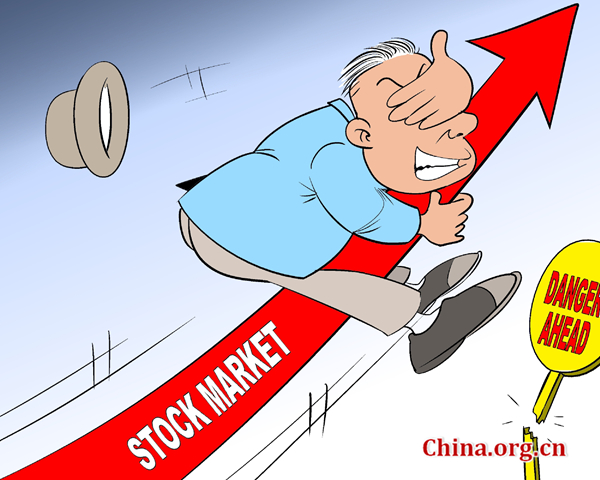A shares to re-embark on surging trends
- By Yi Xianrong
 0 Comment(s)
0 Comment(s) Print
Print E-mail China.org.cn, July 21, 2015
E-mail China.org.cn, July 21, 2015
|
|
|
In the heat [By Jiao Haiyang] |
The Chinese equity market had suffered a three-week plunge. The index tumble began on June 12 after the Shanghai Composite Index climbed to 5,178 points, and by July 7, it had nosedived to a low of 3,507 points, declining more than 33 percent. This was the biggest three-week slump for the A-share market since 1992, and constituted a severe stock-market crisis. To cope with the crisis, the Chinese government had to launch full-scale measures to rescue and stabilize the market. On July 8, the Shanghai Composite Index finally snapped its losing streak to close at 3,709 points. After the turbulent corrections, this is likely to mark a new starting point for the A-share market to re-embark on its continuous surging trend.
To understand why the stock market crisis occurred, it is a must to know and analyze the reasons behind the massive surge before the free fall. An important factor behind the market rally was that the Chinese government wanted to follow the example of the US financial market and wanted to shore up the sagging economy, which has been driven by the real estate industry, through a bullish stock market. The launches of such policies as reductions in interest rates and reserve requirement ratios and the Shanghai-Hong Kong Stock Connect program were all meant to foster a bull stock market.
The A-share market, however, is different from the US equity market. On the one hand, the Chinese stock market is still far from matured and well-developed; on the other hand, the Chinese institutional structure and fundamentals are also greatly different from those of the United States. Under such circumstances when the Chinese government had the intention of fostering a government-intervened "national bull market," stocks investors all developed strong anticipations for surges in the stock market, and the A-share market, for the third times in about 10 years, became a risk-free hedging market.
The Shanghai Composite Index, from the end of June 2014, rose from 2,039 points to 5,178 points in mid-June this year, surging by more than 150 percent with only some minor adjustments and corrections. Such a fast rise or frenzy gave rise to an illusion among the investors that stock investment would be risk-free, and that even blind purchases of stocks would lead to handsome gains and they could make big money through excessive leverage of margin trading.
With the prevailing illusion or fantasy of a risk-free stock market, many investors resorted to high leverage to borrow money to bet on the stock market, particularly with the inflows of excessively leveraged borrowings from the "gray or shadow lenders" or the non-official channels. Pushed by massive inflows of capital, Chinese stock market indexes successively surged to new highs in a short span of time, and along with the market rally, risks were also rapidly accumulating and magnifying. Against such a background, the market regulators had to strictly regulate and curb excessively leveraged financing. The stock market then began to tumble.
The massive slump not only exposed stock-market risks brewed by high leverage financing, but also led to the burst of illusions about the "risk-free market". With the tightening regulation and supervision and in order to mitigate huge risks that were likely to occur with stock-index plunges, panic ensued and anxious investors all wanted to dump their holdings as quickly as possible. This further worsened the declining stock market, and the sell-off rush also magnified risks of the equity market, and ultimately led to the stock-market crisis.







Go to Forum >>0 Comment(s)